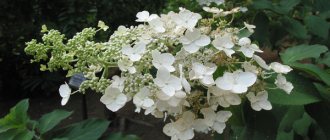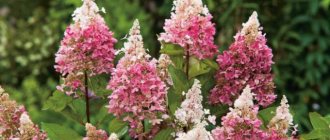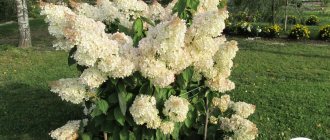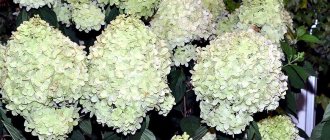In 1986, the Dutch breeder Peter Zwijnenburg released Paniculate Hydrangea Limelight onto the market. It received many awards, and still, 35 years later, remains one of the most sought-after varieties. The unique color of the inflorescences, high frost resistance, strong straight branches that do not require garter, even when overloaded with huge panicle caps, contribute to their popularity.
In Russia, the Limelight variety is sometimes sold under the name Lemon Light.
Botanical description
Hydrangea paniculata Limelight is a round, dense, deciduous shrub with straight, strong, reddish-brown shoots. They not only support the inflorescences well, but also do not bend under gusts of wind or during rainstorms.
The plant holds its shape perfectly and does not need garter or supports.
Foreign sources in the description of the Limelight variety indicate a height without pruning of up to 3 m. In the middle zone, the dimensions are more modest - even with good maintenance, the crown diameter barely reaches 2 m. The root system is powerful, but superficial, extending beyond the trunk circle.
Hydrangea leaves are large, about 10 cm long, with a velvety surface, clear veins and pointed tips. In autumn, the green color of the plates takes on a purple tint.
The annual growth of young Limelight hydrangea is up to 25 cm. An adult bush quickly recovers after short pruning, produces meter-long shoots over the season, and produces large inflorescences at their tips that bloom from early July to September or October.
Hydrangea Limelight forms dense, wide-conical panicles, mainly from four-petalled sterile corollas. Length depends on cutting:
- if this is not done, the Limelight inflorescences become smaller every year, eventually stopping at about 12 cm;
- with a short, 4 buds, panicles are formed about 20-25 cm;
- When growing conditions are good, in addition to annual pruning, shoots are additionally rationed and huge caps are formed, 30 cm long and 20 cm wide at the base.
Hydrangea Paniculata Limelight gained popularity due to the original coloring of the inflorescences. During the budding period and in the initial stages of opening the corollas, it is lime-colored, but in the bright sun it quickly turns into white. Aging flowers take on a pink or purple hue.
On especially large panicles an interesting effect is obtained. The tip of the hydrangea cone is lime, the middle is white, and the base is pinkish.
In partial shade, the greenish tint appears especially brightly and lasts longer.
In the fall, Limelight panicles can be cut off, dried indoors, and collected into a bouquet of dried flowers - they will last all winter and spring. The seeds do not ripen.
Hydrangea Limelight: description and characteristics of the variety
Paniculata hydrangea Limelight: photo of the variety
The Limelight hydrangea variety is considered a deciduous flowering shrub. The plant can grow up to two and a half meters. It grows quite quickly, with annual growth reaching approximately twenty-five centimeters. It has a spreading crown, with the help of which pruning is done; the required shape is simply set.
Herbaceous shoots are straight and hard. The branches have a dark brownish color. During the flowering process, you should not tie them to stakes or install supports.
The foliage of Limelight paniculata hydrangea has a dark greenish color and a velvety front side. In the autumn season, the leaves of this herbaceous plant change color to purple. This gives the bush an even more decorative appearance. The leaves of the herbaceous plant are quite dense, most often they completely hide the branches.
The flowering process of Limelight hydrangea from the beginning of the second summer month until the end of the first autumn month. It happens that if the herbaceous plant is planted in an area sheltered from cold and strong winds, the flowering process can be extended until the second week or until the end of the second autumn month.
The flowers are small in size and immediately after opening they have a rich greenish color. After some time, they acquire a snow-white color, and by the autumn season they change color to pinkish. Their color directly depends on the lighting. In partial and complete shade, the flowers have a rich greenish color, and in a sunny place the flowers have a light greenish color or snow-white.
Limelight hydrangea flowers are collected in large inflorescences in the shape of a regular cone. Their length can be approximately twenty-five centimeters.
Planting in open ground
Growing conditions affect the decorativeness and health of Limelight hydrangea, and an adult plant does not like to be moved. Therefore, the choice of location must be taken responsibly.
It is better to take seedlings from a nursery located to the north of the site. This way the plant goes from worse to better conditions, takes root faster, and enjoys better health throughout its life.
Deadlines
The time for planting Limelight hydrangea depends on the region:
- in the south this is done in the first half of autumn, when the heat subsides, but more than a month remains before frost;
- in the middle zone you can plant Limelight at the beginning or end of the season, at the discretion of the owners;
- for the North-West, Siberia, the Urals, the Far East, the only acceptable time is spring, when the soil warms up to 15 ° C or more, Limelight hydrangea should take root well before winter.
Although container hydrangeas can be planted regardless of the season, except for the hottest months, according to reviews, it is better to place the crop on the site within the specified time frame. This way adaptation happens faster.
Selection and preparation of a site
Limelight hydrangea is a short-day plant; it needs sun less than 12 hours a day, and intense lighting in the south is not necessary at all. There, hydrangea is planted in partial shade, where scorching rays cannot reach the bush.
In the middle zone, direct sun is acceptable in the morning or evening. At midday, Limelight hydrangea needs protection. Planting is done next to a fence, building wall, gazebos or other small architectural forms. You can place Limelight under the canopy of trees with an open crown, but with a deep root system, so that the plants do not compete for water or nutrients.
Garden crops in the northern regions already suffer from a lack of sunlight. In summer, the days there are long, but the radiation intensity is low and photosynthesis is sluggish. Hydrangea Limelight is planted in a well-lit place.
The site should be well-drained, with loose, nutritious, permeable, moist, slightly acidic soil. The culture grows on neutral soils, but the inflorescences there are smaller and not as beautiful as in magazine photos and in the description of the variety.
Soggy lowlands or elevated areas from which the wind quickly blows moisture away are not suitable for Limelight hydrangea.
Where the soil is already acidic and well-structured, it is recommended to additionally add coniferous litter from the nearest pine forest to the planting hole. It will enrich the root zone with mycorrhiza, which is very good for hydrangea. It is recommended to add a little clay to sandstones.
One of the planting mixture recipes if the soil needs to be changed completely:
- sour peat – 1 part;
- coniferous land – 1;
- sand – 0.5;
- matured humus – 0.5.
Landing algorithm
A hole for the hydrangea is dug 40 cm deep and 60 cm in diameter. In the closing areas, it is deeper so that there is room for drainage. Fill with planting mixture and spill with acidified water.
In autumn or spring, depending on the region, planting begins:
- Remove part of the substrate from the pit.
- Place a hydrangea seedling in the center so that the root collar is several centimeters below the edge.
- Cover with the substrate set aside and compress.
- A border strip is dug in around the perimeter of the tree trunk or an earthen roller is built.
- Water with a rooting solution. Each bush uses at least 2 buckets of water.
- Mulch with acidic peat and pine litter. This makes it easier to care for hydrangea - moisture is retained, weeds grow less, and there is no need to loosen the soil.
- The bush is shaded for several days.
You can often come across the statement that it is impossible to bury the root collar - it will dry out. Nothing like this. Hydrangea is a shrub, not a tree, and is also very moisture-loving. If the soil is loose and well permeable, the neck will not dry out, but once above the soil surface, it will certainly dry out in the summer or freeze in the winter.
How to care
When a shrub is planted, it requires care and attention. Caring for hydrangea includes watering, fertilizing, pruning, preparing for winter frosts and, of course, protection from diseases and parasites.
Did you know? In Japan, hydrangea is called Ajisai - “a flower that looks like a purple sun.”
Watering
Attractiveness and flowering directly depend on soil moisture. The tree trunk circle should always be slightly damp. But you also need to make sure that water does not collect, because this can cause the roots to rot. You can also turn on sprinkling, literally 5-10 minutes. in the evening to keep the foliage green.
Top dressing
It is necessary to feed hydrangea in early spring. This will help ensure dense foliage and large inflorescences.
Feeding can be divided by month:
- March. It is necessary to use a mixture of 10 liters of water, 30 g of urea and 30 g of potassium sulfate. Dosage - 6 liters per plant. From organic matter - a solution of 2 liters of manure per 20 liters of water. Dosing - 6 liters per bush. In order for hydrangea to bloom, it will need minerals such as phosphorus and potassium. To do this, you can use 30 g of superphosphate per 10 liters of water. Watering is carried out in the same way as described above;
- June. In order for many buds to appear, you need to use a mixture of nitrophoska (30 g) and Agricola (30 g) per 10 liters of water. Water until completely absorbed;
- July. Fertilizer stimulates the blooming and long-term flowering of hydrangeas. For this, a complex of fertilizers is used, for example, “Kemira flower” (“Fertika”). Dosage: 30 g per 10 liters of water. Water until completely absorbed;
- August. It is necessary to water the soil around the trunk with a mixture of water (10 l) and slurry (1 l). And judging by the reviews, lemon hydrangea loves unusual feedings. For example, once every 15 days you can water with a solution of kefir (1 l) and water (3 l);
- end of September – beginning of October. During this period, fertilizers containing potassium are used, which makes the roots of the bush stronger, which will help withstand winter frosts. 30 g of superphosphate and potassium sulfate are diluted in 10 liters of water. Dosing: 7 liters per bush. To protect the soil from freezing and protect the roots, it is necessary to lay a layer of compost or humus up to 10 cm thick.
Mulching and loosening the soil
After the bush has been watered, it is necessary to loosen the soil in the tree trunk circle. In hot weather, mulching is carried out. To do this, lay out a layer of chopped grass or pine bark.
Important! To give the branches flexibility and make them strong, it is necessary to water with a weak solution of potassium permanganate until completely absorbed. From March to May it is necessary to water 3 times.
Pruning hydrangea
To ensure rapid growth, hydrangeas must be pruned. The branches are cut to 2/3 of their length. This way they stimulate the appearance of new shoots. The ideal time is early April. In October, when the hydrangea fades, it is also necessary to trim off the wilted inflorescences and dried branches. This will protect you from damage under snow piles.
Preparing for winter
Lichta hydrangea (this is another name for the plant) is distinguished by its frost resistance and can easily tolerate low temperatures down to -35°C. But in very young shrubs the branches may freeze, which, in turn, can lead to a lack of flowering next year. For this reason, plants that are not yet 3 years old need to be hidden under shelters.
Important! Before building a shelter for wintering, it is necessary to trim off dried branches and inflorescences.
Before you start wrapping, you must:
- Tilt the shoots and tie them to pegs driven into the ground.
- Sprinkle the bush with fallen leaves and pine branches.
- Place roofing felt on top.
- Fill the holes between the shelter and the bush with dry leaves.
1 - inclined shoots, 2 - hilling, 3 - spruce branches, 4 - lutrasil, 5 - stone
Diseases and pests, control methods and prevention
Hydrangea Lyme is susceptible to diseases such as:
- leaf chlorosis. The foliage becomes yellow, but the veins themselves continue to be green. This occurs due to excess calcium in the soil. To correct the situation, it is necessary to increase the acidity by adding peat and aluminum sulfate (1.5–5 kg per 1 m³). When the yellowness does not go away, it means that the problem is a lack of iron. In this case, fertilizers with iron are used. For example, Agricola. For prevention, it is recommended to mulch with peat or crushed conifer bark and set aside water for irrigation;
- powdery mildew. When the air temperature reaches +18…+25°C, the development of the disease begins. A white coating forms on the foliage and branches. To get rid of powdery mildew, it is necessary to remove damaged leaves and shoots and spray the bush with fungicides. Carry out the procedure 3 times with breaks of 8–9 days;
- leaf spotting. It is distinguished by rounded marks of a grayish-brown color, which over time can turn black. They increase in size and cause foliage to fall. Spotting occurs due to poor lighting and excessive density of shoots. Products containing copper and mancozeb will help fight the disease. It is necessary to spray 3 times with an interval of 15 days;
- gray rot. It appears as a grayish coating on the foliage. The reason is due to thickening of the shoots or excessive moisture. To get rid of rot, it is necessary to cut off damaged leaves and shoots, and the rest of the bush is sprayed with fungicides 2-3 times every 5 days. For prevention, you need to remove weeds and mulch the soil around the tree trunk.
Pests that attack shrubs:
- aphid. Due to damage by these pests, the leaves curl and fall off. When there are few insects, they cannot cause much harm. You can get rid of single aphid attacks with the help of ladybugs, lacewings and hoverflies. To do this, first knock down the colonies of parasites with a stream of soapy water, and then pour a few tablespoons of sugar onto the soil around the tree trunk. It will attract the insects described above. You can also use the traditional method. First you need to prepare a decoction and spray the plant with it. For the decoction you will need: mix 150 g of finely chopped garlic with 5 liters of water. Leave for 15 minutes. Pass through a colander. Before spraying, dilute with water in a 1:1 ratio. If this does not help, then insecticides must be used;
- common spider mite. Hydrangea Limelicht loses its leaf cover when attacked by these pests. Foliage is food for them. You can find out about the presence of parasites by yellowish-brown dots on the leaves. They can be destroyed by spraying with insecticides 3 times with an interval of 8–11 days.
Features of care
Contents Limelight differs little from other paniculate hydrangeas. It is important not to neglect the bush, to do everything on time.
Watering
Irrigation should be so frequent that the soil under the hydrangea does not dry out even for a short time. Pour under each bush:
- 2 buckets of water when short pruning is done in the spring, or Limelight hydrangea is grown on a trunk;
- if the plant is a multi-stemmed tall shrub - 20 liters for every 1 m of growth.
To preserve moisture, mulch the tree trunk circle.
At least once a month under Limelight hydrangea you need to acidify the soil. Use:
- fermented milk products – 2 liters per bucket;
- wine vinegar - 100 g for the same amount of liquid;
- citric acid - from 1 teaspoon to 2 tablespoons, depending on the pH level of the substrate and whether the owners perform the operation regularly or periodically.
It is recommended to settle hard or tap water before watering hydrangeas.
Feeding
Fertilize Limelight four times per season:
- in spring - nitrogen;
- twice - in the summer, with a full mineral complex with microelements, during the protrusion of buds and when the corollas bloom;
- in autumn - potassium and phosphorus without nitrogen.
In summer, it is recommended to use specialized fertilizers for hydrangeas and rhododendrons. There, all nutritional elements are given in a balanced form. You can give the crop fertilizer for conifers marked “summer”.
Before the buds open, it is recommended to alternately treat the crown with a solution of mineral fertilizers or chelates every 14 days. This will make the flowering more lush and the bush healthy - microelements are better absorbed through the leaves. After the corollas bloom, treatments are stopped so as not to reduce the decorative effect.
Trimming
In autumn, only the flower stalks are removed. In the spring, before sap flow begins, short pruning is done, leaving 3-4 internodes on strong shoots. Weak or thickening bushes are removed completely.
If you only carry out sanitary measures and cut off the ends of frozen branches, the hydrangea will be large, dotted with small inflorescences.
Hydrangea Limelight on a trunk is formed as follows:
- One strong shoot is left and tied to a peg, the rest are cut out at the root.
- When it grows to the desired height, the lateral shoots are removed. 3-5 strong branches are left on the top of the head, from which the crown is formed.
- The stem is kept clean by plucking out the awakened buds throughout the season.
Preparing for winter
The first 1-2 years after planting, with the onset of frost, young bushes are tied with spruce branches, or tilted to the ground, covered with leaves or pine needles, and non-woven material is secured on top.
When the Limelight hydrangea takes root, just mulch the tree trunk circle - cover it like a rosebush, but not with soil, but with acidic peat or pine litter. If the branches freeze, don’t worry – they will still need short pruning in the spring.
Limelight hydrangea care
Paniculata hydrangea Limelight: photo of the variety
Hydrangea Limelight paniculata is considered a non-fussy herbaceous plant. The agricultural technology behind it is simple and it will not waste all your time. However, in order to have an abundant flowering process, the herbaceous plant must be endowed with:
- constant hydration.
- fertilization with fertilizers.
- decorative and sanitary trimming.
The bush must be moistened in a timely manner so that the soil under the bush is constantly moist. In the spring and autumn seasons, moistening is carried out every fourteen to twenty-one days. In the summer season on hot days it is necessary to moisturize more than once or twice every seven days.
Limelight hydrangea is fertilized every year to ensure proper development and stimulation of the flowering process. Without fertilizer, the flowering process can become weak, and sometimes the shrub has no flowering process at all.
Fertilization begins in the last month of spring during the process of abundant growth. Before the first buds form, they are fed with nitrogen fertilizers. An ordinary infusion of cow manure brings excellent results. With this fertilizer, the shrub forms a green mass and prepares for the flowering process.
With the formation of the first buds and before the completion of the flowering process, fertilize with potassium and phosphorus fertilizers. Specialized fertilizers for Limelight hydrangea are very well known, which can be purchased in special supermarkets and flower farms.
A necessary process in agricultural technology for this plant is its pruning. The following classifications of pruning are known:
- sanitary
- formative.
- rejuvenating.
The shrub is decorated at the beginning of the spring season before the buds open. At the same time, you must try not to touch all last year’s branches, because it is on them that the buds will form.
Others, if they are quite elongated, are reduced by two thirds, others are reduced by one third or less. In this case, the shrub is given the necessary shape. It is also worth cutting off shoots growing in the center of the crown to reduce its density.
Sanitary pruning is carried out at the end of the second autumn month. Remove all wounded, dried and infected branches. All thin shoots and mature flowers are also trimmed, reducing the branches by two to three buds.
For fairly mature Limelight panicle hydrangea shrubs, rejuvenating pruning is done in the spring season. All adult shoots are pruned, leaving four to five youngest shoots untouched. They are reduced without touching four to five kidneys. Sometimes radical pruning is done.
Prevention of diseases and pests
Limelight is a hydrangea variety with strong immunity. Most problems arise due to lack or errors of care; the best prevention is careful selection of the planting site and proper agricultural technology.
But pests and diseases still occur on Limelight:
- if an anthill grows next to hydrangeas, aphids colonize the young growths;
- in dry summers and with poor watering, spider mites appear on the leaves;
- walnut “shares” the sooty fungus with hydrangea;
- Powdery mildew is not uncommon during rainy, cold summers.
Owners do not often do preventive treatments for Limelight hydrangea. Problems are usually resolved as they arise.
Methods for propagating hydrangea
Cuttings are the most convenient way to propagate Hydangia paniculata Limelight. Cuttings are selected that are lignified during spring pruning or green in summer:
- you need to take fragments that show 2 nodes;
- cut diagonally from the bottom, directly under the bud;
- The branch can be cut straight from the top, stepping back a few centimeters from the bud;
- the rooting substrate is prepared in equal parts of sand and peat;
- the cuttings are placed in a mini-greenhouse, treated with root formation stimulants;
- when planting, the lower bud is deepened;
- water with warm water.
Cuttings of paniculata hydrangea take root in 30-40 days. Plants bloom in 2-3 years of development.
Use in landscape design
Hydrangea Limelight in landscape design is suitable for creating gardens in a romantic or informal style, for zoning areas. It is planted in the foreground of tree groups, as a tapeworm, as undergrowth in a large area or as a hedge that does not require cutting.
The shrub looks good next to conifers or against the background of a lawn. Without annual pruning, it grows tall and can cover up a dilapidated building, a garbage heap or other unsightly corner.
Planting and caring for Limelight hydrangea is not particularly difficult. To get spectacular, large lime inflorescences, it is important to place the bush correctly, water it abundantly and often, prune it short in the spring, and feed it throughout the season.
Details
The best place to plant Hydrangea paniculata
Hydrangea should only be planted in prepared soil. First of all, it is necessary to free the soil from weeds. Plants such as dandelions, wheatgrass and plantain can compete for nutrients. If you don't pull them out from the beginning, their root systems can become intertwined.
The size of the planting hole should be 2 times larger than the seedling's earthen ball. Most often, the inner layers of the soil are poor, so the hole must be fertilized, especially if there is clay and sand.
It is important to make sandy soil a little heavier by adding compost or garden soil. To reduce moisture conductivity.
The heavy clay composition of the soil also needs to be diluted, making it lighter. You can add sifted sand or vermiculite. This substance is not subject to rotting, is not washed out of the soil, and does not react to alkalis and acids. Vermiculite and its analogues are sterile, they are not interesting to microorganisms and rodents, and mold does not appear in it. Moreover, vermiculite is enriched with iron, aluminum, and magnesium, which is very important for Limelight hydrangeas.
Important! If the soil is predominantly clay or silty, gravel and sand should be poured into the bottom of the loosened planting hole. This promotes better moisture conduction to the roots and gets rid of excess water.
Rules for selecting seedlings and their preparation
Limelight hydrangea seedlings must be absolutely healthy. It is better to purchase them in specialized garden nurseries or from friends. The good condition of the planting material is indicated by lush foliage and elastic shoots. In the case when spots are visible on the leaves, there is rot, growths and mold on the branches, you should not buy such a seedling. Not only will it not survive, but it will also harm other garden plants.
When purchasing, you need to inspect not only the upper part of the bush, but also the root system. If the seedling is in a container, you need to carefully remove it. Hydrangea roots are thin, so you don’t need to put any effort into extracting them. Before planting, the container can be carefully cut or moistened with an earthen ball for easier release from the container.
The roots can sometimes weave into a lump at the bottom; this part must be carefully cut off with sharp scissors, and the remaining rhizomes must be carefully straightened.
Attention! Sometimes it turns out that the lump of soil in the container is very dry. To moisturize it, just soak it in water until it is completely saturated. This procedure does not exclude watering after burying the seedling in the soil.
Procedure for planting Limelight hydrangea. After all the preparatory work has been completed, paniculata hydrangea can be planted in the ground. This procedure consists of several stages:
- 3 parts of the total depth of the recess must be filled with soil mixed with humus, peat, sand and pine soil, and 30 g of superphosphate is added there.
- the seedling is placed in a hole on an earthen hill;
- fill the recess with the prepared mixture and compact it;
- the root collar should remain level with the ground;
- You need to use a bucket of water per plant after planting.
The final stage is mulching the surface with peat, sawdust or straw. A layer of mulch retains moisture and protects the roots from overheating on hot days.
Rules of care
The Limelight hydrangea variety is not difficult to care for. The most important thing is to water the bush on time and trim it periodically. When watering, you need to focus on the condition of the soil; it should always be moist, but not wet. If the summer is dry, sometimes you can simulate rain using a watering can or a special nozzle on the hose.
Care in spring begins with feeding the plant. The first of them occurs during the period of snow melting and urea is used. For the solution you need to take 20 g of the substance and 10 liters of water. For one bush you will need 2-3 buckets of liquid. This watering will stimulate growth and activate the active phase after winter sleep.
When buds begin to form, complex fertilizer formulations are needed, which are diluted according to the instructions on the package.
Proper pruning of Limelight hydrangeas
Trimming a plant is a very important stage in its care; it is carried out twice - in autumn and spring. The second is carried out after flowering, and it is necessary to cut off the dried inflorescences. This reduces the stress on the plant shoots.
In spring, pruning is necessary for the correct formation of outlines. This must be done before the sap flows, initially getting rid of dead and damaged shoots. Last year's branches are cut down to the fifth bud from the bottom for renewal. At the end, the entire bush is thinned out and the shoots that grow inward are cut off.
Important! To rejuvenate an old hydrangea, pruning is carried out to create a stump. In this case, all shoots are cut off. This will not result in a lack of summer flowering because the variety produces inflorescences on young branches. In plants under 2 years old, it is necessary to cut off the first buds to stimulate shoot growth.
Winter hardiness of Limelight hydrangea
The Limelight variety is quite frost-resistant, so no preparation is needed for adult plants. Such measures are necessary only in very cold regions of the country. A mulching layer of manure is used for cover, and the crown itself is covered with a special agrofibre material or burlap.
These actions must be done with all young plants; if snow falls, you can sprinkle it with it.
How to propagate Limelight Paniculata hydrangea?
Hydrangea, like other plants, can be propagated in several ways. If we talk about the seed method, it is only suitable for natural varieties, because the seeds do not transmit all the genetics from the mother bush.
Moreover, this method is very time-consuming and labor-intensive. After preparing the seeds and planting them in containers, the seedlings are planted when they reach 3 years of age; until this time they grow in greenhouses.
It is easier to get a new plant by dividing the bush. This option goes well with the need to replant or thin out an adult hydrangea bush.
The most used propagation method is cuttings. It involves cutting off young shoots. The top of the cut part is removed and only 3 leaves are left. It is better to leave the cuttings in water with a root growth stimulator, so the process will be faster.
Fertilizers for plants
Since fertilizers were applied to the planting hole before planting the plant in the open soil layer, the flower does not need to be fed in the first 12 months. Fertilizers will need to be applied to the soil cover starting next year in order to activate the growth of the bush and the formation of buds. During the season it is necessary to perform 3 feedings.
Mineral mixtures
At the stage of bud formation, it is necessary to use complex fertilizing. To do this, it is permissible to use a fertilizer intended for flowering shrubs, or nitroammophoska. The latter can be used in dry or liquid form. Substance in the amount of 2 tbsp. l. You will need to bring it under the bush and dig it in or dissolve it in 10 liters of water. It is advisable to carry out the procedure at the end of June.
The crop is fed with potassium-phosphorus fertilizers in September. To do this, you will need to add 3 tbsp under the bush. l. potassium and 1/2 cup superphosphate. Fertilizing must be incorporated into the soil layer.
Organic fertilizers
Organic fertilizers must be used during the period of blooming of the first leaves. To do this, the plant must be shed with an infusion of urea or mullein (2 tablespoons of the substance must be dissolved in a bucket of water). If the flower is cultivated in a temperate climate, fertilizing must be done in mid-May.
To acidify the soil layer, the tree trunk circle of the plant must be watered with a solution made on the basis of 5 g of citric acid and 10 liters of liquid. The procedure must be performed once every 24 months.
Cuttings of Hydrangea paniculata in autumn after pruning
After pruning the bush, many removed shoots remain. They can be thrown away or used for propagation. Not all shoots can be used as cuttings. Small, weakened branches can be immediately put aside, choosing a strong shoot of the current year without obvious flaws or diseases.
- Remove the inflorescence from the top. If the branch is quite long, it may produce two or three cuttings. Remember - there must be at least three pairs of buds on the cutting.
- On each cutting, remove the lower leaves and shorten the upper ones (if they still remain).
- You need to prepare containers for cuttings in advance and fill them with soil mixture for Hydrangeas (slightly acidic).
- To increase the chance of germination, dip the cuttings in Kornevin and insert them into the container.
- The soil should be well watered.
Containers with cuttings should be kept in winter in room conditions at a lower temperature (about 12-15 degrees). Don't forget to water the pots.
Plant propagation instructions
Cuttings should be carried out in July by cutting cuttings from the upper shoots. Before planting, the cuttings will need to be soaked for 1 day in a solution that stimulates the growth of the root system.
Then you will need to proceed directly to the planting procedure:
- It is necessary to prepare a container up to 1 m wide and 50 cm deep.
- Next, you need to fill it ¾ full with a soil mixture based on coarse sand, earth and peat.
- The cuttings will need to be placed in the substrate to a depth of 6 cm and covered with a layer of sand 1 cm thick, maintaining a distance of at least 7 cm between them.
- Afterwards, the container with the trimmings should be covered with polyethylene and placed in a dark place with a temperature of +23 °C.
- In the future, it is necessary to irrigate the soil layer with water until the liquid is completely absorbed.
After 4 weeks under normal conditions, root formation should occur. The container with the plant will need to be moved from the street to the shelter from October to April. After 36 months, the seedlings will have become stronger and will be ready to be transplanted into the open soil layer.
Limelight hydrangea planting diagram.
Plant propagation by layering involves digging the stem near the bush without cutting it from the mother plant:
- After spring pruning, the branch must be placed in a hole and covered with earth.
- The rooted seedling will be ready by August.
- During this period, the cuttings should be separated from the bush. Then it will be able to produce new shoots.
- Next, the plant can be transferred to a permanent habitat.
Dividing the bush is acceptable for an adult plant with a formed root. Reproduction should be carried out in spring or autumn with cutting off a small part in the ground or completely digging up the crop. The roots should be shortened by 2 cm before planting.
Recommended planting times
The best time to plant hydrangea is spring, the last ten days of April or the first of May. Seedlings in containers are transferred to the site later. In the south they are planted in September.
Selection and preparation of planting material
Seedlings of the paniculata variety Limelight are purchased in gardening centers in containers. Make sure that they are swollen and that the buds and trunk are without damage. If there are already leaves, their plates should be unaffected by pests. Before planting, place the pot with the seedling in a large container of water so that you can easily remove the lump of earth without damaging the delicate roots of the paniculate hydrangea.
Possible difficulties in growing
In the process of cultivating paniculate hydrangea of the Limelight variety, some difficulties may arise. Since young bushes that have not reached three years of age have a weak root system, they need to be protected. To do this, plant seedlings must be covered with special material or spruce branches. It is recommended to cover the tree trunk circle with peat or sawdust.
The roots of the plant may rot. The cause of the problem is the incorrect location of the flower. Garden crops are not recommended to be planted in low-lying areas where water regularly stagnates. As a result, the seedling may die.
Hydrangea foliage may turn yellow and chlorosis may appear. The problem arises when cultivating a plant in an alkaline soil layer. The flower may not grow if it is planted in limed soil.
Where to buy and cost of the plant
Limelight hydrangea seedlings can be purchased at nurseries or flower centers that specialize in breeding garden plants. The price of planting material starts from 350 rubles. The cost is affected by the age of the seedling, its size and type of root system.
Hydrangea variety "Limelight" is characterized by a long flowering stage and flowers of various colors. The description and photo make it possible to understand how to care for a garden plant so that the flower retains its decorative and compact shape.











